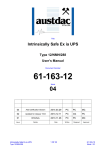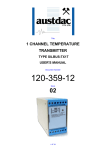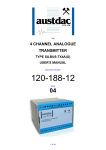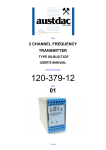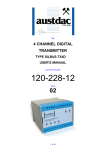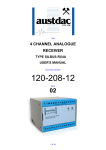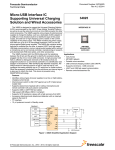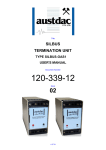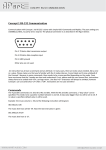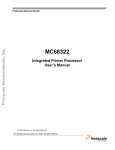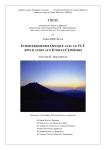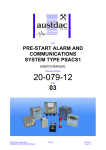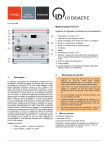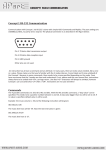Download user manual
Transcript
Title 4 CHANNEL DIGITAL RECEIVER TYPE SILBUS-RX4D USER'S MANUAL Document Number 120-248-12 Issue 04 1 OF 31 REVISION CONTROL 04 Minor Corrections 2014.06.26 PB' CG PC 03 Add configuration upload and download. Add low and high power relay contact variants Add NAND NOR FLIP functions 2010.11.12 PB’ PB’ JY 02 Fix specs, add prog info 2010.02.02 PB’ PB’ JY 01 Original 2009.02.10 PB’ PB’ JY Issue Details Date Written Designed Approved Austdac Pty Ltd Unit 1 / 4 Packard Avenue Castle Hill NSW 2154 Australia PO Box 6486 Baulkham Hills Business Centre NSW 2153 Australia Phone: + 61 2 8851 5000 Fax: + 61 2 9899 2490 Website: www.austdac.com.au Austdac Inc. 455 Lowries Run Rd, Pittsburgh, PA 15237 USA Phone: +1 888 254 9155 Fax: +1 412 635 0179 Copyright 2010-11-12 This document remains the property of Austdac Pty. Ltd. It is subject to its recall and must not be reproduced in part or whole or its contents divulged to third parties without prior written approval from Austdac Pty Ltd. 4 CHANNEL DIGITAL RECEIVER TYPE SILBUS-RX4D USER'S MANUAL 2 OF 31 120-248-12 Issue: 04 TABLE OF CONTENTS REVISION CONTROL .................................................................................................................... 2 TABLE OF CONTENTS .................................................................................................................. 3 PHOTOGRAPHS ............................................................................................................................ 4 TABLES .......................................................................................................................................... 4 FIGURES ........................................................................................................................................ 4 1 GENERAL DESCRIPTION .......................................................................................................... 5 2 FRONT PANEL LAYOUT ............................................................................................................. 5 3 THEORY OF OPERATION .......................................................................................................... 7 3.1 LOGIC FUNCTIONS ............................................................................................................. 7 3.2 THE FLIP FUNCTION ........................................................................................................... 9 3.3 OUTPUT RELAY SWITCHING POWER ............................................................................. 10 4 OPERATING INSTRUCTIONS .................................................................................................. 11 5 CONFIGURATION ..................................................................................................................... 11 5.1 CONSOLE PORT OPERATION .......................................................................................... 12 5.2 help COMMAND ................................................................................................................. 12 5.3 REPEAT COMMAND .......................................................................................................... 13 5.4 VERSION COMMAND ........................................................................................................ 14 5.5 STACK COMMAND ............................................................................................................ 14 5.6 SILBUS MAP COMMAND ................................................................................................... 14 5.7 SILBUS STATUS COMMAND............................................................................................. 15 5.8 SILBUS GET COMMAND ................................................................................................... 15 5.9 LOGIC COMMAND ............................................................................................................. 16 5.10 ADD COMMAND ............................................................................................................... 16 5.11 DELETE COMMAND ........................................................................................................ 17 5.12 SBOUT COMMAND .......................................................................................................... 18 5.13 SSYNC COMMAND .......................................................................................................... 19 5.14 ONFLT COMMAND........................................................................................................... 20 5.15 OFFFLT COMMAND ......................................................................................................... 20 5.16 DISPLAY COMMAND ....................................................................................................... 21 5.17 UPLOAD CONFIGURATION COMMAND ......................................................................... 22 5.18 DOWNLOAD CONFIGURATION COMMAND ................................................................... 23 5.19 CONFIGURATION RECORDS.......................................................................................... 25 6 TERMINATIONS AND CONNECTIONS .................................................................................... 26 6.1 RELAY OUTPUT PORTS ................................................................................................... 26 6.2 POWER INPUT PORT ........................................................................................................ 27 6.3 SILBUS NETWORK PORT ................................................................................................. 27 7 CERTIFICATION ....................................................................................................................... 27 7.1 INSTALLATION CONFIGURATION 1 ................................................................................. 28 7.2 INSTALLATION CONFIGURATION 2 ................................................................................. 29 8 SOFTWARE REVISION AND DISPLAY .................................................................................... 30 9 SPECIFICATIONS ..................................................................................................................... 31 4 CHANNEL DIGITAL RECEIVER TYPE SILBUS-RX4D USER'S MANUAL 3 OF 31 120-248-12 Issue: 04 PHOTOGRAPHS Photograph 1 SILBUS-RX4D front panel ........................................................................................ 6 Photograph 2 Access to console port and programming switch ...................................................... 6 Photograph 3 Laptop connected to console port via MEAN1 interface .......................................... 12 Photograph 4 Hyper Terminal delay setup .................................................................................... 24 TABLES Table 1 SILBUS-RX4D switching capabilities................................................................................ 10 Table 2 Status LED flash sequence meanings .............................................................................. 11 Table 3 SILBUS-RX4D Configuration record................................................................................. 25 Table 4 Digital input termination details......................................................................................... 26 Table 5 Power input port termination details ................................................................................. 27 Table 6 SILBUS network port termination details .......................................................................... 27 FIGURES Figure 1 Multi-term logic function .................................................................................................... 7 Figure 2 S-AND logic function and resolver cascading .................................................................... 8 Figure 3 FLIP logic Function ........................................................................................................... 9 Figure 4 SIBUS-RX4D Connection diagram .................................................................................. 26 Figure 5 SILBUS-RX4D segregation and isolation levels .............................................................. 27 Figure 6 Installation configuration 1 .............................................................................................. 28 Figure 7 Installation configuration 2 .............................................................................................. 29 4 CHANNEL DIGITAL RECEIVER TYPE SILBUS-RX4D USER'S MANUAL 4 OF 31 120-248-12 Issue: 04 1 GENERAL DESCRIPTION The four channel digital receiver is part of a family of explosion protected DIN rail mounting modules that transmit to and receive from an Austdac SILBUS field bus network. The SILBUS-RX4D can receive from just a few through to many digital ON/OFF signal from a SILBUS network to control the four relay outputs directly or via complex multi-term logic functions. The digital receiver has four output relays controlled by up to six logic resolvers capable of implementing OR, AND, NOR, NAND, FLIP and S-AND logic functions. Each resolver has an independently configurable output ON and OFF delay filter to allow implementation of simple timer functions. The four digital outputs are galvanically isolated from each other, from the power supply port and the SILBUS network port. This isolation allows the SILBUS-RX4D to provide many simple and highly effective solutions when used in installations involving intrinsically safe and non-intrinsically safe circuits. The four channel digital receiver is available in two output contact power switching variants to cover all applications of the receiver. The two variants are the SILBUS-RX4D-L for low power switching applications and the SILBUS-RX4D-H for high power switching applications. See the specifications section for actual switching capacities. For the remainder of the manual the generic SILBUS-RX4D will be used instead of two individual types. The receiver is housed within a DIN rail mounting enclosure measuring 100mm (W) x 75mm (H) x 110mm (D). The front panel is located between the two top of enclosure mounted terminal blocks to provide a clear view of the operation indicating LED’s. Four LED’s, one for each channel, are provided to indicate the status of each of the output relays. A further two LED’s are provided to show power and SILBUS network status. The SILBUS-RX4D can be quickly and simply configured using a laptop computer running Hyper Terminal and a small plug in programming adaptor. Each digital output can be independently programmed to any SILBUS channel address. Each digital input can also have it’s de-bounce timer independently programmed between 500ms and 10s in 100ms increments. 2 FRONT PANEL LAYOUT The four channel digital receiver front panel is located between the terminal blocks that form part of the enclosure. Located in the top right hand corner of the front panel are the STATUS and POWER indication LED’s. The green power LED is illuminated whenever a 12 volt supply is connected to the receiver. The yellow status LED flashes at different rates to indicate the operational status of the receiver, see table 2 for more details. On the lower left of the front panel are four green LED’s labelled from one through to four, these LED’s indicate the status of the four digital relay outputs. A LED is illuminated to indicate an on or active output and extinguished to indicate an off or inactive output. The front panel is shown in photograph 1. 4 CHANNEL DIGITAL RECEIVER TYPE SILBUS-RX4D USER'S MANUAL 5 OF 31 120-248-12 Issue: 04 The front panel can be snapped out and removed by using a wide bladed flat screw driver to gain access to the configuration (console) port and programming switch. Photograph 2 below shows the front panel removed and the location of the console port and programming switch. Photograph 1 SILBUS-RX4D front panel Photograph 2 Access to console port and programming switch 4 CHANNEL DIGITAL RECEIVER TYPE SILBUS-RX4D USER'S MANUAL 6 OF 31 120-248-12 Issue: 04 The black four pin console port connector and the red programming switch are located behind the lower right corner of the front panel label. 3 THEORY OF OPERATION 3.1 LOGIC FUNCTIONS The four channel digital receiver has been furnished with six configurable multi-term logic gates or logic resolvers, four of which drive the four general purpose relay outputs. These logic resolvers are typically used to implement conveyor ‘OR’ and ‘AND’ functions for emergency stop or remote isolation. The six basic logic functions are ‘OR’, ‘AND’, ‘NAND’, ‘NOR’, ‘FLIP’ and ‘S-AND’ while ‘S-NAND’ is possible by inverting the input terms. ‘S-AND’ and ‘S-NAND’ allow the two bit safety channels to be used as a single term in the logic resolver. COMMON DATABASE A1 B7 D4 M1 P8 G2 LOGIC RESOLVER A2 RELAY FILTER ON: 0.5 Sec OFF: 3.0 Sec DRIVE H6 J3 Figure 1 Multi-term logic function Each logic resolver has a maximum number of input terms equal to the size of the connected SILBUS network or system database i.e. 128, 64, 32, 16 or 8. The input terms can be specified in any order and do not need to be sequential. Channels assigned for analink, fastlink, datalink or sync transmission should not be used as input terms of the logic functions, otherwise unpredictable results will be obtained. The output of the logic resolver is fed via a filter with independently variable on and off filter periods before being applied to the relay output. The on and off filter times can be independently configured from 100mS to hours in 100mS steps. The filter on and off times are used to stop intermittent signals from causing inadvertent trips and alarms. The filter on time ensures that the output from the logic resolver must be on for the ‘on’ filter period before the relay output will be asserted. The filter off time ensures that the output from the logic resolver must be off for the ‘off’ filter period before the relay output will be negated. The timers can be used to implement simple timer related functions when delays are needed in system control sequences. The filtered logic resolver output can be transmitted back onto the SILBUS network for use in further logic operations and to be read by the network channel generator or by a test unit 4 CHANNEL DIGITAL RECEIVER TYPE SILBUS-RX4D USER'S MANUAL 7 OF 31 120-248-12 Issue: 04 for indication purposes. Figure 1 shows the layout of one of the first four logic resolvers (1, 2, 3 and 4) that have the capability to drive an output relay. The SILBUS-RX4D has a further two logic resolvers (5 and 6) that do not have output relays but otherwise function identically. These two logic resolvers can be used to implement multi-term logic functions and then provide a single output that is feed back for use as an input term of one of the other logic resolvers. This is useful when combining safety channels and normal digital channels in the same logic function, as the S-AND function and the standard AND/OR functions can not be handled by the one logic resolver. By combining logic and timer functions simple RS type latch functions can also be implemented by the SILBUS-RX4D. The logic resolver functions and outputs are only updated during the SILBUS SYNC pulse period at the end of each SILBUS scan period. System designers should take this and the associated delays into account when implementing and configuring the logic resolvers. If the relay output is required to be operated from a single SILBUS channel then a singleterm ‘AND’ or ‘OR’ logic function should be implemented. The ‘S-AND’ safety function is used with safety channels and not only takes into account the status of the safety channel but also includes the quality or validity of the safety channel in the logic function. The ‘S-AND’ logic function can only accept safety channel input terms, the inclusion of standard digital channels as input terms will result in unpredictable outputs from the ‘S-AND’ logic function. The ‘S-AND’ logic function also needs to know the safety sync channel address, typically A1 as shown in figure 2. Safety and standard digital channels can be combined in logic operations by cascading logic resolvers as shown in the following figure. SAFETY SYNC CHANNEL A1 A3 A5 A7 B3 B5 SAFETY SYNC CHANNEL ADDRESS = A1. SAFETY SYNC CHANNEL IS REQUIRED BY S-AND FUNCTION BUT IS NOT CONSIDERED AN INPUT TERM. LOGIC RESOLVER 1 S-AND COMMON DATABASE RELAY 1 FILTER ON: 0.2 Sec OFF: 0.9 Sec DRIVE M1 M2 M3 P8 J4 LOGIC RESOLVER 2 OR C4 RELAY 2 FILTER ON: 1.5 Sec OFF: 2.1 Sec DRIVE G4 CHANNEL C4 IS USED AS A METHOD OF CASCADING ONE LOGIC RESOLVER TO ANOTHER. CHANNEL C4 CAN'T BE USED BY ANY FIELD TRANSMITTER AND CAN'T BE MODIFIED VIA THE MODBUS INTERFACE Figure 2 S-AND logic function and resolver cascading When logic resolver outputs are fed back onto the SILBUS network for inclusion in subsequent logic resolvers the designer should ensure that these feedback channels are not modified by field devices or the channel generator. 4 CHANNEL DIGITAL RECEIVER TYPE SILBUS-RX4D USER'S MANUAL 8 OF 31 120-248-12 Issue: 04 The configuration and use of these logic resolvers is further explained in the configuration section of this manual. 3.2 THE FLIP FUNCTION The FLIP logic function implements a D type flip flop with feedback to produce a toggling ‘flip’ function which is useful in implementing single way road block light systems. A schematic of the FLIP function is shown in the figure below. COMMON DAT ABASE LOGIC RESOLVER 1 Vcc 1. J3 IS T HE ENTRY SWITCH / TRANSMITT ER TO SINGLE WAY ROAD 2. REQUIRE A J3 T RANSMIT TER AT EACH END OF SINGLE WAY ROAD 3. K6 USED T O DRIVE RECEIVER AT FAR END OF SINGLE WAY ROAD 4. ON POWER UP RESOLVER / RELAY 1 IS DE-ENERGISED = RED LIGHT 5. EACH T IME J3 IS ASSERT ED THE FLIP FLOP WILL T OGGLE 6. T HE TOGGLE ONLY OCCURS DURING THE DUPLINE SYNC PULSE SET Q FUNCTION FLIP J3 INPUT T ERM CLK 'D' T YPE FLIP FLOP D RELAY Q OUT PUT FILT ER ON: 0.2 Sec OFF: 2.2 Sec DRIVE RESET POWER RESET K6 OUT PUT TERM Figure 3 FLIP logic Function The FLIP function occupies one logic resolver and has one configurable input term and one configurable output term. The FLIP function also uses the SILBUS-RX4D power on reset signal in its operation, this does not need to be configured it is automatically assigned when the FLIP function is selected. During the SILBUS SYNC pulse period the FLIP function looks for the input term (J3) to be asserted (turned on) during the last SILBUS scan period and if so will toggle the ‘D’ type flip flop which results in the logic resolver output (K6) being changed to its opposite state i.e. if it was off it is now on or if it was on it is now off. The output relay can be used to drive a set of traffic lights to control the single way road. The output term is also sent back onto the SILBUS network so that a digital receiver with a single term AND function can be used to control the traffic lights at the remote end of single way road. A digital transmitter configured to J3 and located at either end of the single way road is used to control the block light system. If the input term (J3) is held on or asserted over many SILBUS scan periods the flip flop of the FLIP function will not continue to toggle, the clock input to the ‘D’ type flip flop is edge sensitive and requires the input term to be negated and then asserted again before another toggle will take place. The power on reset signal ensures that the ‘D’ type flip flop of the FLIP function comes up in a known state i.e. the output term is not on or asserted (green light). By combining other logic resolvers with the FLIP function more sophisticated control systems can be implemented. 4 CHANNEL DIGITAL RECEIVER TYPE SILBUS-RX4D USER'S MANUAL 9 OF 31 120-248-12 Issue: 04 3.3 OUTPUT RELAY SWITCHING POWER The SILBUS-RX4D is available in two versions that have different relay contact switching capabilities. The SILBUS-RX4D-L variant for low power switching capabilities and the SILBUS-RX4D-H variant for high power and high voltage switching capabilities. The table below shows the differences between the two models. SILBUS-RX4D SWITCHING POWERS PARAMETER SILBUS-RX4D-L Pm 25W Pi 25W Um 25V Ui 25V Ii 1A Minimum switching voltage 1V Minimum switching current 10uA Minimum switching power 10uW Contact material Rhodium SILBUS-RX4D-H 100W 100W 250V 25V 3A 12V 250mA 3W Tungsten Table 1 SILBUS-RX4D switching capabilities The SILBUS-RX4D-H is only recommended for use where powers higher than 3 watts, voltages greater than 12V and currents greater than 250mA are being switched. The SILBUS-RX4D-H was specifically designed for use in the US market where 110V contactors are being switched directly by the SILBUS-RX4D-H. The SILBUS-RX4D-H is not recommended for use in Australian installations where low touch potential regulations are in place. The SILBUS-RX4D-L is designed for use in a hazardous area where intrinsically safe circuits or extra low voltage control signals are being switched. The SILBUS-RX4D-H can be used in Australian installations provided that the minimum switching requirements and touch potential issues are dealt with satisfactorily. Operating the SILBUS-RX4D-H below the specified minimum switching requirements will result in intermittent and unreliable operation of the output relay contacts. Similarly, operating the SILBUS-RX4D-L above its maximum switching capabilities will also result in unreliable operation of the output relay contacts and possibly result in welded or open-circuit contacts. 4 CHANNEL DIGITAL RECEIVER TYPE SILBUS-RX4D USER'S MANUAL 10 OF 31 120-248-12 Issue: 04 4 OPERATING INSTRUCTIONS The four channel digital receiver does not require any operator action to operate once it has been installed within an IP54 host enclosure and configured correctly. An understanding of the various flash sequences of the yellow status LED may be required to help in the trouble shooting and maintenance of the entire SILBUS network installation. The status LED provides information on the operational status of the receiver and the connected SILBUS network. This information includes correct microprocessor operation, health of connected SILBUS network, selection of an invalid SILBUS channel address and indication of software version number. The table below shows the various flash sequences and their meaning. FLASH SEQUENCE NONE – LED ON OR OFF CONTINUOUSLY OFF CONTINUOUSLY 1 SECOND ON 1 SECOND OFF LONG PERIOD OFF FOLLOWED BY 3 SHORT FLASHES MAJOR REVISION FLASH SEQUENCE – PAUSE – MINOR REVISION FLASH SEQUENCE STATUS LED FLASH SEQUENCES NAME MEANING INTERNAL MICROPROCESSOR FAULT OR NO NO FLASH POWER RECEIVER FUNCTIONING – NO SILBUS NO FLASH CONNECTED TO SILBUS PORT RECEIVER FUNCTIONING – HEALTHY SILBUS FAST FLASH CONNECTED TO SILBUS PORT ONE OR MORE LOGIC TERMS HAVE BEEN PAUSE – 3 ASSIGNED TO AN INVALID SILBUS CHANNEL SHORT ADDRESS I.E. P8 FOR A 64 CHANNEL SILBUS FLASH NETWORK SOFTWARE VERSION SEQUENCE INDICATES THE SOFTWARE VERSION LEVEL OCCURS IMMEDIATELY AFTER POWER UP. SEE SOFTWARE REVISION SECTION OF THIS MANUAL FOR DETAILS Table 2 Status LED flash sequence meanings The console port power source selection switch SW1 must always be in the run position for correct operation of the receiver. The run position is with the small slide actuator pushed furthest away from the black four pin console connector X111. The front panel has four green LED’s numbered one to four that are illuminated whenever the associated relay is energised. 5 CONFIGURATION The four channel digital receiver has several operational parameters that require configuration prior to use. All of these parameters can be viewed and changed via the console port. The console port consists of a small four pin connector and a two position slide switch behind the front panel label. Access to the console port can be gained by snapping out the front panel using a wide bladed flat screw driver in one of the slots between the front panel and terminal blocks. To use the console port an Austdac MEAN1 interface, A to B USB cable and laptop computer running Hyper Terminal are required. For more detail on the console port, MEAN1 interface and their use refer to Austdac document 53-018-12. 4 CHANNEL DIGITAL RECEIVER TYPE SILBUS-RX4D USER'S MANUAL 11 OF 31 120-248-12 Issue: 04 5.1 CONSOLE PORT OPERATION The console port should be connected to a laptop running a terminal emulation program such as Hyper Terminal via the Austdac interface type MEAN1 and a USB cable as shown in the following photograph. Photograph 3 Laptop connected to console port via MEAN1 interface The SILBUS-RX4D certification places restrictions on what may be connected to the console port, the connection of an interface other than the Austdac MEAN1 to the console port will invalidate the certification of the receiver. The terminal emulation program should be configured to 19200 baud, 8 data bits, one stop bit, no parity, no flow control and DEC VT100 terminal emulation. Once communications have been established with the SILBUS-RX4D, it will display a screen of information that includes software version, software checksum, and a list of commands followed by the console port prompt. The prompt includes an abbreviation of the receiver type number. RX4D::> Commands are invoked by entering the command name followed by any optional modifiers, keywords and the “ENTER” key. The enter key is shown in the following examples as a “ ” symbol. 5.2 HELP COMMAND The HELP command prints a list of all available commands and shows the syntax for each command. Optional command modifiers are shown within [ ] while mandatory modifiers are shown within < >. An example of a screen output follows: RX4D::>HELP 4 CHANNEL DIGITAL RECEIVER TYPE SILBUS-RX4D USER'S MANUAL 12 OF 31 120-248-12 Issue: 04 Software 1V04 0xCBF0 Configuration 0x049D SN:09041000 Commands: --------------------------------------------------------------------------------********** Level 1: Standard Menu ********** HELP [1…7] Level of Help Display Help Menu REPEAT [LF] [Refresh rate in seconds] Repeat Previous Command VER Firmware Version and Checksum STACK Display Peak Stack Usage SBMAP Display SILBUS I/O Map SBSTAT Display SILBUS Status SBGET <A1–P8> Display a SILBUS Channel State SSYNC [<SET> <Safety Sync Address>] Select safety sync address LOGIC <SET> <RELAY> <OFF | N/AND | N/OR | SAND | FLIP> Select logic function ADD <SET> <RELAY> <Term | !Term | Term#> Add terms to relay DEL <SET> <RELAY> <Term | !Term | Term#> Delete terms from relay SBOUT <SET> <RELAY> <SILBUS Address> Select relay O/P address ONFLT [<SET> <RELAY> <On time in mS>] Set on filter time OFFFLT [<SET> <RELAY> <Off time in mS>] Set off filter time DISP [<RELAY> <Text | Map>] Display relay logic function CFGUP Upload Configuration Text CFGDWN Download Configuration Text ------------------------------------------------------------------RX4D::>_ 5.3 REPEAT COMMAND The REPEAT command is used after another command to continuously repeat that command. As an example the SBGET command can be executed followed by the REPEAT command to provide a continuously updating display of the selected SILBUS channel. The display will continue to update until any key is hit. The SILBUS-RX4D will respond by displaying the prompt. RX4D::>SBGET D1 D1 = ON RX4D::>REPEAT D1 = OFF RX4D::>_ In the above example the “OFF” changed to an “ON” whenever SILBUS channel D1 was activated. In this mode the repeat command writes over the previously displayed information, if required, the repeat command can be made to refresh the information on a new line by entering LF (line feed) as part of the command invocation. The repeat command refreshes the display every one second by default. The refresh rate can be slowed by entering the refresh rate in seconds as part of the repeat command as shown in the following command: RX4D::>REPEAT LF 5 D1 = OFF D1 = OFF D1 = ON 4 CHANNEL DIGITAL RECEIVER TYPE SILBUS-RX4D USER'S MANUAL 13 OF 31 120-248-12 Issue: 04 D1 D1 D1 D1 = = = = OFF OFF ON OFF RX4D::>_ As can be seen from the above example the repeat command refreshed the status of SILBUS channel D1 on a new line every five seconds. In the LF mode a record of the status of D1 can be viewed on the screen. 5.4 VERSION COMMAND The VERSION command is used to display the serial number, abbreviated type number, software version and program memory checksum of the SILBUS-RX4D. The command can be invoked as shown in the following example: RX4D::>VER SN:09124321 RX4D 1V01 0XB12F RX4D::>_ This command is useful when the user needs to know the software version or serial number. The program memory checksum is useful to confirm that a software update has completed successfully without any programming errors. 5.5 STACK COMMAND The STACK command is provided to allow the technician to gauge the health of the SILBUS-RX4D microprocessor and its code by displaying the maximum usage of the program stack. The display is a peak value of the stack usage since the SILBUS-RX4D was powered up. The command can be invoked as shown in the example below: RX4D::>STACK Stack usage/size = 312/1024 Percentage Used = 30% RX4D::>_ This command would typically only be used when requested by an Austdac software engineer. 5.6 SILBUS MAP COMMAND The SILBUS map command allows the operator to obtain a snapshot of the SILBUS network to which the receiver is connected. The map shows all of the SILBUS channels available on the network. The map consists of a table with a heading of groups below which is displayed the channels using ones and zeros. Each group is shown vertically with 1 at the top and 8 at the bottom. A one indicates an ON channel and a zero indicates an OFF channel. An example of an SBMAP is shown below with channels A4, P7 and P8 on or active: 4 CHANNEL DIGITAL RECEIVER TYPE SILBUS-RX4D USER'S MANUAL 14 OF 31 120-248-12 Issue: 04 RX4D::>SBMAP ABCDEFGHIJKLMNOP 0000000000000000 0000000000000000 0000000000000000 1000000000000000 0000000000000000 0000000000000000 0000000000000001 0000000000000001 RX4D::>_ The SBMAP command is particularly useful when used with the repeat command as this will display a continuously updated table. 5.7 SILBUS STATUS COMMAND The SILBUS status command displays the number of SILBUS channels available on the connected SILBUS network, a SILBUS synchronisation pulse count and a SILBUS error count. This command is used to determine if the connected SILBUS network is functioning correctly and how many channels are available. The error count should typically be zero while the sync count should be incrementing. Once again the use of the repeat command will provide a dynamic updating display. An example of the SBSTAT command follows: RX4D::>SBSTAT No. Chan = 128, Sync Count = 17807, Error Count = 0 RX4D::>_ The error count will be non zero whenever the connected SILBUS network is out of specification. The error count can be non zero if the connected SILBUS network channel generator has its power supply cycled off and on. These error counts should be ignored. 5.8 SILBUS GET COMMAND The SILBUS get command is used to display the status of one selected SILBUS channel only. If this command is used in conjunction with the repeat command a continuously updating display can be achieved. The command is invoked by entering the command name followed by the desired channel address as shown in the two examples below: RX4D::>SBGET M3 M3 = OFF RX4D::>SBGET B7 B7 = ON RX4D::>_ 4 CHANNEL DIGITAL RECEIVER TYPE SILBUS-RX4D USER'S MANUAL 15 OF 31 120-248-12 Issue: 04 5.9 LOGIC COMMAND This command is used to display and configure the logic function type of the matrices logic resolvers or output relays of the SILBUS-RX4D. The SILBUS-RX4D has six logic resolvers, matrices or relays but only the first four are fitted with actual output relays. The valid logic functions are OR, NOR, AND, NAND, FLIP, SAND and OFF. The current logic type of the output relays can be displayed by simply entering the command name as shown in the example below: RX4D::>LOGIC Relay Matrix[1] Relay Matrix[2] Relay Matrix[3] Relay Matrix[4] Relay Matrix[5] Relay Matrix[6] is is is is is is FLIP AND OR OFF SAND FLIP RX4D::>_ If the command name is entered with additional attributes the logic function can be configured to any of the valid logic types i.e. AND, NAND, FLIP, OFF, OR, NOR, SAND. An example of configuring relay 1 is shown below: RX4D::>LOGIC SET 1 AND Matrix logic changed Relay Matrix[1] is AND Relay Matrix[2] is AND Relay Matrix[3] is OR Relay Matrix[4] is OFF Relay Matrix[5] is SAND Relay Matrix[6] is OFF RX4D::>_ 5.10 ADD COMMAND This command is used to configure the specified logic resolver, matrix or output relay by allowing terms to be added to the logic function. The terms are in the form of valid SILBUS channel addresses and groups. Terms may also be inverted to allow negative logic to be used. The add command does not display current logic resolver configuration. See the DISP command for information on displaying the current configuration. Examples of adding terms to logic matrix 3 using the ADD command are shown below: RX4D::>ADD SET 3 B1 Matrix terms added Relay Matrix[3] = B1 RX4D::>_ The first example shows the first term B1 being added to the matrix or resolver. RX4D::>ADD SET 3 B2,B3 4 CHANNEL DIGITAL RECEIVER TYPE SILBUS-RX4D USER'S MANUAL 16 OF 31 120-248-12 Issue: 04 Matrix terms added Relay Matrix[3] = B1+B2+B3 RX4D::>_ The second example shows two terms B2 and B3, delimitated by a comma, being added to the matrix or resolver. Valid delimiters are space, comma, plus and asterisk. The delimiters are not significant when entering terms i.e. + does not force an OR function and * does not force an AND function. The logic function is determined when using the LOGIC command. The + and * are allowed to increase readability. However when the terms are being displayed after the ADD command has been invoked the + and * are significant i.e. + indicates an OR while an * indicates an AND function. RX4D::>ADD SET 3 B4+!B5,B6+B7 Matrix terms added Relay Matrix[3] = B1+B2+B3+B4+!B5+B6+B7 RX4D::>_ The third example shows four terms B4, B5, B6 and B7 being added to the matrix or resolver. The B5 term is preceded by an exclamation mark to indicate inverted logic or a NOT. Therefore the logic function will be true only when B5 is inverted or negated. RX4D::>ADD SET 3 C# Matrix terms added Relay Matrix[3] = B1+B2+B3+B4+!B5+B6+B7+C# RX4D::>_ The last example shows what appears to be a single term but is in fact the entire SILBUS C group (eight terms). The SILBUS group is represented by the # character. The FLIP function can only have one term for its input. 5.11 DELETE COMMAND This command is used to configure the specified logic resolver, matrix or output relay by allowing terms to be deleted from the logic function. The terms are in the form of valid SILBUS channel addresses and groups. The delete command does not display current logic resolver configuration. See the DISP command for information on displaying the current configuration. Examples of deleting terms from logic matrix 4 using the DEL command are shown below: RX4D::>DEL SET 4 B7 Matrix terms deleted Relay Matrix[4] = C#*D#*!E1*E2 RX4D::>_ The first example shows the term B7 being removed from the AND logic function of relay four. Note that SILBUS groups C and D and channel E1 still remain in the logic function. RX4D::>DEL SET 4 C1 Matrix terms deleted Relay Matrix[4] = C2*C3*C4*C5*C6*C7*D#*!E1*E2 4 CHANNEL DIGITAL RECEIVER TYPE SILBUS-RX4D USER'S MANUAL 17 OF 31 120-248-12 Issue: 04 RX4D::>_ The second example shows the term C1 being removed from the logic function. Note that the SILBUS-RX4D converted the group term C# into the remaining seven individual terms. RX4D::>DEL SET 4 C2*C3+C4,C5,C6*C7*D# Matrix terms deleted Relay Matrix[4] = !E1*E2 RX4D::>_ The third example shows the entire D group and the remaining terms of the C group being removed from the logic function. Note the use of mixed delimiters. RX4D::>DEL SET 4 E1 Matrix terms deleted Relay Matrix[4] = E2 RX4D::>_ The last example shows the inverted logic term E1 being removed from the logic function. Note that the exclamation mark is not entered when deleting inverted logic terms. 5.12 SBOUT COMMAND This command is used to display and configure the SILBUS channel addresses of the six logic resolver or matrix outputs. The current assigned relay output SILBUS channels can be displayed by simply entering the command name as shown in the example below: RX4D::>SBOUT Relay Matrix[1] Relay Matrix[2] Relay Matrix[3] Relay Matrix[4] Relay Matrix[5] Relay Matrix[6] map map map map map map to to to to to to DISABLE J3 K4 DISABLE J5 J6 RX4D::>_ If the command name is entered with additional attributes the matrix output can be assigned a SILBUS channel address. Note that the matrix output SILBUS channel will be transmitted to the connected SILBUS network by the SILBUS-RX4D. There is no restriction on the SILBUS addresses; they do not have to be in numerical order or from the same group. An example of configuring relay matrix 1 is shown below: RX4D::>SBOUT SET 1 K7 Matrix mapping changed Relay Matrix[1] map to Relay Matrix[2] map to Relay Matrix[3] map to Relay Matrix[4] map to Relay Matrix[5] map to Relay Matrix[6] map to 4 CHANNEL DIGITAL RECEIVER TYPE SILBUS-RX4D USER'S MANUAL K7 J3 K4 DISABLE J5 J6 18 OF 31 120-248-12 Issue: 04 RX4D::>_ The above example shows the format of the command when the address is configured. The keyword “SET” is required to invoke a change; the number of the SILBUS-RX4D output is next, followed by the SILBUS channel address. If a SILBUS-RX4D output is not to be assigned a SILBUS channel address then the keyword “DISABLE” is used to stop the output from driving the local resolver database and the connected SILBUS network. 5.13 SSYNC COMMAND This command is used to display and configure the safety sync channel address for those relay matrices that have been assigned a SAND logic function. The current assigned safety sync channel address can be displayed by simply entering the command name as shown in the example below: RX4D::>SSYNC Relay Matrix[1] Relay Matrix[2] Relay Matrix[3] Relay Matrix[4] Relay Matrix[5] Relay Matrix[6] Safety Safety Safety Safety Safety Safety Sync Sync Sync Sync Sync Sync channel channel channel channel channel channel is is is is is is DISABLE DISABLE DISABLE DISABLE A1 A3 RX4D::>_ If the command name is entered with additional attributes the safety sync address can be assigned a SILBUS channel address. The safety sync is generated by a safety receiver connected to the SILBUS network. Each SILBUS-RX4D relay matrix can be assigned an individual safety sync channel or they can be the same depending on which safety channel is associated with which safety receiver. As a general rule of thumb safety sync channels should be assigned channel addresses in the early part of a standard SILBUS network pulse train i.e. group A. An example of configuring relay matrix 1 is shown below: RX4D::>SSYNC SET 1 A1 Matrix safety sync address changed Relay Matrix[1] Safety Sync channel Relay Matrix[2] Safety Sync channel Relay Matrix[3] Safety Sync channel Relay Matrix[4] Safety Sync channel Relay Matrix[5] Safety Sync channel Relay Matrix[6] Safety Sync channel is is is is is is A1 DISABLE DISABLE DISABLE A1 A3 RX4D::>_ The above example shows the format of the command when the safety sync address is configured. The keyword “SET” is required to invoke a change; the number of the SILBUS-RX4D relay matrix is next, followed by the SILBUS channel address of the safety sync. If a SILBUS-RX4D relay matrix does not use the SAND logic function then it should not be assigned a safety sync channel address. Use the keyword “DISABLE” to stop the 4 CHANNEL DIGITAL RECEIVER TYPE SILBUS-RX4D USER'S MANUAL 19 OF 31 120-248-12 Issue: 04 logic resolver from referencing what appears as a pulsing digital input that may result in an unpredictable logic output. 5.14 ONFLT COMMAND This command is used to display and configure the on delay filter of the six relay matrices. These filters stop the output relays from picking up on noise and transients. The current assigned on delay filter can be displayed by simply entering the command name as shown in the example below: RX4D::>ONFLT Relay on filter times are: Relay[1] on time is 100mS Relay[2] on time is 100mS Relay[3] on time is 100mS Relay[4] on time is 100mS Relay[5] on time is 100mS Relay[6] on time is 100mS RX4D::>_ If the command name is entered with additional attributes the on delay filter can be configured to a value suitable for the installation. The on delay filter can be set from 0mS to 20 seconds in 100mS increments. The time is entered in milliseconds. An example of configuring the on delay filter for relay matrix 1 is shown below: TX4D::>ONFLT SET 1 1200 Relay On time adjusted Relay on filter times are: Relay[1] on time is 1200mS Relay[2] on time is 100mS Relay[3] on time is 100mS Relay[4] on time is 100mS Relay[5] on time is 100mS Relay[6] on time is 100mS RX4D::>_ The above example shows the format of the command when the on delay filter is configured. The keyword “SET” is required to invoke a change; the number of the SILBUS-RX4D relay matrix is next, followed by the new on delay filter value in milliseconds. 5.15 OFFFLT COMMAND This command is used to display and configure the off delay filter of the six relay matrices. These filters stop the output relays from dropping out on noise and transients. The current assigned off delay filter can be displayed by simply entering the command name as shown in the example below: TX4D::>OFFFLT 4 CHANNEL DIGITAL RECEIVER TYPE SILBUS-RX4D USER'S MANUAL 20 OF 31 120-248-12 Issue: 04 Relay off filter times are: Relay[1] off time is 100mS Relay[2] off time is 100mS Relay[3] off time is 100mS Relay[4] off time is 100mS Relay[5] off time is 100mS Relay[6] off time is 100mS RX4D::>_ If the command name is entered with additional attributes the off delay filter can be configured to a value suitable for the installation. The off delay filter can be set from 0mS to 20 seconds in 100mS increments. The time is entered in milliseconds. An example of configuring the off delay filter for relay matrix 2 is shown below: RX4D::>ONFLT SET 2 900 Relay off time adjusted Relay off filter times are: Relay[1] off time is 100mS Relay[2] off time is 900mS Relay[3] off time is 100mS Relay[4] off time is 100mS Relay[5] off time is 100mS Relay[6] off time is 100mS RX4D::>_ The above example shows the format of the command when the off delay filter is configured. The keyword “SET” is required to invoke a change; the number of the SILBUS-RX4D relay matrix is next, followed by the new off delay filter value in milliseconds. 5.16 DISPLAY COMMAND The display command is used to provide a summary of the relay logic resolver configurations. The current relay matrix configurations can be displayed by simply entering the command name as shown in the example below: RX4D::> # LOGIC 1 OFF 2 OR 3 AND 4 OFF 5 SAND 6 OFF DISP O/P SS -- -J3 -K1 --- -K4 A1 -- -- ONFLT 10000 100 1100 100 100 100 OFFFLT 1200 1000 100 100 100 100 TERMS -D1+D2+D3 B1*B4*B5*B6*B7 -B#*C#*D#*E1*E2 -- RX4D::>_ The above example shows all relays at the same time. The display can be reduced to one logic matrix by using additional attributes. Examples of altering the output format of the display command follow: 4 CHANNEL DIGITAL RECEIVER TYPE SILBUS-RX4D USER'S MANUAL 21 OF 31 120-248-12 Issue: 04 RX4D::> DISP 3 MAP Relay Matrix[3] ABCDEFGHIJKLMNOP x1xxxxxxxxxxxxxx xxxxxxxxxxxxxxxx xxxxxxxxxxxxxxxx x1xxxxxxxxxxxxxx x1xxxxxxxxxxxxxx x1xxxxxxxxxxxxxx x1xxxxxxxxxxxxxx xxxxxxxxxxxxxxxx OR K1 5 1100 -100 RX4D::>_ The above example uses the MAP keyword to alter the display command output format to show the relay configuration in a GSW1 map layout. A don’t care term is depicted by a small ‘x’ while a positive logic term is indicated by a ‘1’ and an inverted or negative logic term is shown by a ‘0’. The second last line shows the logic function at the left, the output channel address in the centre and the number of terms in the logic function at the right. The last line shows the on delay filter value at the left, the safety sync address in the centre and the off delay filter value at the right. RX4D::> DISP 3 TEXT Relay Matrix[3] = B1*B4*B5*B6*B7 RX4D::>_ The above example uses the TEXT keyword to alter the display command output format to just show the resolver terms in Boolean format. The plus sign, asterisk and exclamation mark are significant in this display format. The terms displayed in reverse text are currently asserted or true indicating that the AND logic resolver only needs B7 to become asserted and the logic resolver output will be true. This display format is extremely useful when used in conjunction with the repeat command to find which terms are asserted and which terms are negated and stopping the logic resolver output from becoming true and allowing the conveyor to start. 5.17 UPLOAD CONFIGURATION COMMAND The upload configuration command is used to extract the configuration profile of the SILBUS-RX4D via the MEAN1 interface and record it in a file on a PC. Having an exact copy of the configuration is useful for record keeping and future cloning of new SILBUSRX4D receivers for maintenance or system expansion. The upload is invoked by entering the command name without any attributes as shown in the example below. RX4D::>CFGUP CFGDWN 4 CHANNEL DIGITAL RECEIVER TYPE SILBUS-RX4D USER'S MANUAL 22 OF 31 120-248-12 Issue: 04 S00300000FC S11300000000001001022E008056000105000000CF S113001080000000800000008000000080000000DC S11300208000140008001E00090028000A000000D7 S113003080000000800000006492000011002ED9AE S9030000FC RX4D::>_ The configuration is uploaded and displayed on the screen in Motorola S1-S9® HEX format. This data format includes headers and checksums to guard against errors and corruption of the data. The first line of the uploaded configuration is the keyword “CFGDWN” this does not form part of the data but is included to help with the configuration download process, see section 5.17 below for details. To save the configuration to a file, open Notepad or a similar non-word processing editor, highlight the uploaded configuration as indicated below and copy to Notepad via the clipboard. The Notepad file should then be saved with a meaningful title that reflects the application e.g. RX4D_xxx.CFG. When highlighting the uploaded configuration, ensure that the invisible carriage returns (CR) at the end of all lines are included. Also ensure that the CFGDWN keyword is included. RX4D::>CFGUP CFGDWN S00300000FC S11300000000001001022E008056000105000000CF S113001080000000800000008000000080000000DC S11300208000140008001E00090028000A000000D7 S113003080000000800000006492000011002ED9AE S9030000FC RX4D::>_ The copy and paste method is used in this manual because it is the most universal method that works with all terminal emulation programs such as HyperTerminal®. Do not use an editor that introduces hidden formatting characters as a future download may not work with these characters in place. Many terminal emulation programs have automatic means to upload the configuration directly into a file; these are not described here as they differ from program to program but there is no restriction on using these features. Austdac is planning to release a complete tool to allow direct upload, download and editing of the configuration profile. 5.18 DOWNLOAD CONFIGURATION COMMAND The download configuration command is used to take a previously saved configuration from a file and download it to the target SILBUS-RX4D receiver. This method of configuration ensures exact cloning during maintenance and system expansions. Communications with the target must first be established via the MEAN1 interface and a terminal emulation program such as Hyper Terminal®. The cursor should be left at the SILBUS-RX4D prompt as follows. 4 CHANNEL DIGITAL RECEIVER TYPE SILBUS-RX4D USER'S MANUAL 23 OF 31 120-248-12 Issue: 04 RX4D::>_ Open the previously saved configuration file in Notepad or a similar non-word processing editor and highlight the configuration as shown below. CFGDWN S00300000FC S11300000000001001022E008056000105000000CF S113001080000000800000008000000080000000DC S11300208000140008001E00090028000A000000D7 S113003080000000800000006492000011002ED9AE S9030000FC Copy and paste the configuration from Notepad to the RX4D::> prompt in Hyper Terminal as shown below. Note CTRL-V does not work in Hyper Terminal. RX4D::>CFGDWN S00300000FC S11300000000001001022E008056000105000000CF S113001080000000800000008000000080000000DC S11300208000140008001E00090028000A000000D7 S113003080000000800000006492000011002ED9AE S9030000FC RX4D::>_ The first line of the configuration contains the keyword “CFGDWN” which instructs the target to accept the data records. This “CFGDWN” keyword should have been copied from a previous upload and saved in the configuration file. Automatic file transmission features of the terminal emulation program may be used to download configuration files. Photograph 4 Hyper Terminal delay setup The terminal emulation program should be set up to allow a 100mS wait period after the carriage return at the end of each line during a download, this gives the target time to process the incoming data. 4 CHANNEL DIGITAL RECEIVER TYPE SILBUS-RX4D USER'S MANUAL 24 OF 31 120-248-12 Issue: 04 5.19 CONFIGURATION RECORDS SILBUS-RX4D CONFIGURATION RECORD SILBUS NETWORK LOCATION CONFIGURATION CHECKSUM RESOLVER 1 LOGIC FUNCTION RESOLVER 1 NUMBER OF TERMS RESOLVER 1 OUT ADDRESS RESOLVER 1 ON FILTER TIME RESOLVER 1 OFF FILTER TIME RESOLVER 1 SAFETY SYNC ADDRESS RESOLVER 1 TERMS RESOLVER 2 LOGIC FUNCTION RESOLVER 2 NUMBER OF TERMS RESOLVER 2 OUT ADDRESS RESOLVER 2 ON FILTER TIME RESOLVER 2 OFF FILTER TIME RESOLVER 2 SAFETY SYNC ADDRESS RESOLVER 2 TERMS RESOLVER 3 LOGIC FUNCTION RESOLVER 3 NUMBER OF TERMS RESOLVER 3 OUT ADDRESS RESOLVER 3 ON FILTER TIME RESOLVER 3 OFF FILTER TIME RESOLVER 3 SAFETY SYNC ADDRESS RESOLVER 3 TERMS RESOLVER 4 LOGIC FUNCTION RESOLVER 4 NUMBER OF TERMS RESOLVER 4 OUT ADDRESS RESOLVER 4 ON FILTER TIME RESOLVER 4 OFF FILTER TIME RESOLVER 4 SAFETY SYNC ADDRESS RESOLVER 4 TERMS RESOLVER 5 LOGIC FUNCTION RESOLVER 5 NUMBER OF TERMS RESOLVER 5 OUT ADDRESS RESOLVER 5 ON FILTER TIME RESOLVER 5 OFF FILTER TIME RESOLVER 5 SAFETY SYNC ADDRESS RESOLVER 5 TERMS RESOLVER 6 LOGIC FUNCTION RESOLVER 6 NUMBER OF TERMS RESOLVER 6 OUT ADDRESS RESOLVER 6 ON FILTER TIME RESOLVER 6 OFF FILTER TIME RESOLVER 6 SAFETY SYNC ADDRESS RESOLVER 6 TERMS Table 3 SILBUS-RX4D Configuration record The table above can be used to record the SILBUS-RX4D configuration. 4 CHANNEL DIGITAL RECEIVER TYPE SILBUS-RX4D USER'S MANUAL 25 OF 31 120-248-12 Issue: 04 6 TERMINATIONS AND CONNECTIONS All connections to the four channel digital receiver are via cage-clamp terminals around the perimeter and near the front of the DIN rail mounting enclosure, these terminals can accommodate up to 4mm2 conductors. There are 16 possible connections to the receiver; these are shown in the following tables and diagrams: 16 N/C 17 COM CH 1 SIG 1 16 N/C COM 2 17 COM SILBUS NETWORK +VS1 SIG 1 CH 1 COM 2 4 CHANNEL DIGITAL RECEIVER TYPE SILBUS-RX4D 20 COM CH 2 21 N/O 22 N/C 23 COM CH 3 24 N/O 25 N/C 26 COM CH 4 27 N/O 19 N/C 20 COM CH 2 21 N/O LOAD 2 22 N/C 23 COM +VS2 -VS1 CH 3 24 N/O 25 N/C 26 COM LOAD 3 CH 4 SIGNAL COMMON LOAD 1 19 N/C 4 CHANNEL DIGITAL RECEIVER TYPE SILBUS-RX4D 18 N/O 18 N/O 27 N/O +VS3 +VE 14 -VS2 +VE 14 -VE 15 -VE 15 -VS3 Figure 4 SIBUS-RX4D Connection diagram 6.1 RELAY OUTPUT PORTS Each digital output is provided with three terminals for the connection of field wiring to the changeover or form C output contacts. Each output contact is capable of switching a maximum voltage of 250 volts, a maximum current of 3 amperes and a maximum power of 100 watts. OUTPUT CH1 CH2 CH3 CH4 RELAY OUTPUT TERMINATIONS INDICATION TERMINAL DESCRIPTION LED 16 CH1 NORMALLY CLOSED CONTACT 17 1 CH1 CHANGEOVER CONTACT 18 CH1 NORMALLY OPEN CONTACT 19 CH2 NORMALLY CLOSED CONTACT 20 2 CH2 CHANGEOVER CONTACT 21 CH2 NORMALLY OPEN CONTACT 22 CH3 NORMALLY CLOSED CONTACT 23 3 CH3 CHANGEOVER CONTACT 24 CH3 NORMALLY OPEN CONTACT 25 CH4 NORMALLY CLOSED CONTACT 26 4 CH4 CHANGEOVER CONTACT 27 CH4 NORMALLY OPEN CONTACT Table 4 Relay output termination details Each digital output is galvanically isolated from the other outputs and the remainder of the receiver circuitry and ports; this allows the SILBUS-RX4D to be used in a variety of special ways that include connecting non-intrinsically safe signals to the digital outputs while the receiver is connected to both intrinsically safe SILBUS networks and power supplies. 4 CHANNEL DIGITAL RECEIVER TYPE SILBUS-RX4D USER'S MANUAL 26 OF 31 120-248-12 Issue: 04 6.2 POWER INPUT PORT The four channel digital receiver operates from a nominal 12 volt DC supply. The power supply operating range is from 7.5 volts through to 12.6 volts. The SILBUS-RX4D consumes less than 62mA from the power supply. The table below shows the power input port connection details. TERMINAL 14 15 POWER INPUT PORT TERMINATIONS DESIGNATION DESCRIPTION +VE 12V POWER SUPPLY +VE INPUT -VE 12V POWER SUPPLY –VE OR COMMON INPUT Table 5 Power input port termination details 6.3 SILBUS NETWORK PORT The SILBUS network port provides a means for the receiver to be connected to a SILBUS network. Any connections to a SILBUS field bus network pair should be of a multi-drop nature with spur lengths kept to a minimum. This will minimize any reflections and therefore communications errors in the SILBUS network. TERMINAL 1 2 SILBUS NETWORK PORT TERMINATIONS DESIGNATION DESCRIPTION SIG SILBUS NETWORK SIGNAL COM SILBUS NETWORK COMMON Table 6 SILBUS network port termination details The table above shows the SILBUS network port connections. 7 CERTIFICATION The four channel digital receiver type SILBUS-RX4D has been awarded IECEx certification under IECEx TSA 07.0002X, Ex ia I, as part of the Dupline / SILBUS system. The certification requires that the SILBUS-RX4D be mounted within a host enclosure that provides a minimum ingress protection of IP54 (IP55 for Queensland Australia). Figure 5 SILBUS-RX4D segregation and isolation levels Because of the segregation and isolation between the various ports of the SILBUS-RX4D it may be used in three different installation configurations that offer considerable flexibility in 4 CHANNEL DIGITAL RECEIVER TYPE SILBUS-RX4D USER'S MANUAL 27 OF 31 120-248-12 Issue: 04 its application when dealing with intrinsically safe and non-intrinsically safe circuits. As shown in the figure 5 the three major port areas are segregated from each other to IEC60079-11 375 volts as indicated by the green dotted lines. The four digital output channels are further segregated from each other to IEC 60079-11 30 volts as indicated by the magenta dotted lines. The digital output terminals, the SILBUS network terminals and the power port terminals are all separated from each other by more than 50mm. The individual digital output channel terminals are separated from each other by more than 6mm. These segregations and separations combine to allow the following installation configurations (see Austdac drawing 120-251-19 for more detail): • Configuration 1 – Installation within the hazardous area with connection of only intrinsically safe circuits. • Configuration 2 – Installation within the safe area with connection of an intrinsically safe SILBUS network. Powered from an intrinsically safe power supply located in the safe area. Connection of non-intrinsically safe digital outputs. Careful attention should be paid to the segregation of wiring in all of these configurations as incorrectly segregated wiring could negate the segregation and safety of the receiver. 7.1 INSTALLATION CONFIGURATION 1 16 N/C 17 COM SILBUS NETWORK +VS1 SIG 1 CH 1 COM 2 20 COM CH 2 21 N/O LOAD 2 22 N/C 23 COM +VS2 -VS1 CH 3 24 N/O 25 N/C 26 COM LOAD 3 CH 4 SIGNAL COMMON SAFE AREA HAZARDOUS AREA 19 N/C 4 CHANNEL DIGITAL RECEIVER TYPE SILBUS-RX4D 18 N/O LOAD 1 27 N/O +VS3 +VE 14 -VS2 -VE 15 -VS3 Figure 6 Installation configuration 1 This configuration allows the four channel digital receiver to be located wholly within the hazardous area and the connection of intrinsically safe circuits to its various ports. The digital outputs can drive four loads powered from the same intrinsically safe source or drive four loads powered from different intrinsically safe sources because of the segregation between the four digital input channels. For the same reason the power supply port can be driven from the same source as the digital outputs or from an entirely different intrinsically safe source without the need for an assessment of voltage or current addition. 4 CHANNEL DIGITAL RECEIVER TYPE SILBUS-RX4D USER'S MANUAL 28 OF 31 120-248-12 Issue: 04 As always, careful attention should be paid to the segregation of wiring in this configuration as incorrectly segregated wiring could negate the segregation and safety of the receiver. 7.2 INSTALLATION CONFIGURATION 2 This configuration allows the four channel digital receiver to be located wholly within the safe area, the connection of an intrinsically safe SILBUS network, be powered from an intrinsically safe power supply and the connection of non-intrinsically safe digital outputs. This configuration is possible because of the segregation and isolation between the SILBUS network port and the remainder of the receiver. 16 N/C 17 COM SILBUS NETWORK +VS1 SIG 1 CH 1 COM 2 LOAD 2 22 N/C 23 COM +VS2 -VS1 CH 3 24 N/O 25 N/C 26 COM LOAD 3 CH 4 SIGNAL COMMON CH 2 21 N/O 27 N/O +VS3 HAZARDOUS AREA 20 COM SAFE AREA 19 N/C 4 CHANNEL DIGITAL RECEIVER TYPE SILBUS-RX4D 18 N/O LOAD 1 +VE 14 -VS2 -VE 15 -VS3 Figure 7 Installation configuration 2 This configuration allows an intrinsically safe SILBUS network to be interfaced with nonintrinsically safe digital outputs. This is particularly useful in the controlling of tripper drives in underground conveyor installations. This configuration eliminates the need for certified barriers or interposing relays. Obviously the segregation of the intrinsically safe SILBUS network and power supply port is of paramount importance in this configuration. Incorrectly segregated SILBUS network wiring could negate the segregation and safety of the receiver and the entire SILBUS network installation. 4 CHANNEL DIGITAL RECEIVER TYPE SILBUS-RX4D USER'S MANUAL 29 OF 31 120-248-12 Issue: 04 8 SOFTWARE REVISION AND DISPLAY The software version of the four channel digital receiver type SILBUS-RX4D will vary as its functionality is improved at the request of our customers. The software version is given in two parts, the major revision level and the minor revision level and is written in the following format: VERSION M.mm where M represents the major revision level and mm represents the minor revision level. E.g. VER 1.12 The software version can be determined by using the console port or by watching the yellow status LED immediately after power up. The software version will be indicated by a sequence of longer flashes for the major revision level, a long pause to indicate the decimal point and a further sequence of shorter flashes representing the minor revision level. Therefore software version 1.12 would be represented by the sequence “one longer flash, a long pause, followed by 12 shorter flashes”. 4 CHANNEL DIGITAL RECEIVER TYPE SILBUS-RX4D USER'S MANUAL 30 OF 31 120-248-12 Issue: 04 9 SPECIFICATIONS Name ............................................................................................. 4 Channel Digital Receiver Type (high power switching contacts) .......................................................... SILBUS-RX4D-H Type (low power switching contacts) ............................................................. SILBUS-RX4D-L Number of digital logic resolvers with relay outputs ................................................................ 4 Number of digital logic resolvers ......................................................6 (2 without output relays) Resolver logic functions ...................................................... OR AND NOR NAND SAND FLIP Digital output timer filter range ................................................... 500ms to 10s in 100ms steps Digital output format ..................................One voltage free form C (SPDT) contact per output SILBUS-RX4D-H maximum output switching voltage ..............................120 VDC or 250 VAC SILBUS-RX4D-H maximum output switching current ........................................................... 3A SILBUS-RX4D-H maximum output switching power ....................................................... 100W SILBUS-RX4D-H minimum output switching power ............................................................ 3W SILBUS-RX4D-H minimum output switching voltage ......................................................... 12V SILBUS-RX4D-H minimum output switching current .................................................... 250mA SILBUS-RX4D-H contact material............................................................................. Tungsten SILBUS-RX4D-L maximum output switching voltage ......................................... 25 VDC or AC SILBUS-RX4D-L maximum output switching current............................................................ 1A SILBUS-RX4D-L maximum output switching power .......................................................... 25W SILBUS-RX4D-L minimum output switching power ........................................................ 10uW SILBUS-RX4D-L minimum output switching voltage ........................................................... 1V SILBUS-RX4D-L minimum output switching current......................................................... 10uA SILBUS-RX4D-L contact material .............................................................................. Rhodium Console port configuration ............................................. 19200 baud, 8 data, 1 stop, No parity Terminations ............................................................................... Cage clamp 4mm2 maximum Size............................................................................... 100mm (W) x 75mm (H) x 110mm (D) Mass ................................................................................................................................ 600g Fixing ......................................... TS35 DIN rail or screw mount M4 on 85mm x 61mm centres Ingress protection ............................................................................................................. IP20 Enclosure material ............................................................ Polycarbonate (30%GV) UL 94 V-1 Enclosure colour .............................................................................................. RAL 7032 Grey Terminal material .............................................................................. Polycarbonate UL 94 V-2 Terminal block colour ........................................................................................................ Blue Operating temperature range .................................................................................0ºC to 40ºC Storage temperature range ................................................................................ -20ºC to 80ºC Operating relative humidity range ...............................................10% to 90% Non condensing Power supply operating voltage range ............................................................. 7.5 to 12.6VDC Power supply current consumption .................. 6mA plus 14mA per energised relay maximum Note: SILBUS-RX4D-H requires a minimum load for operation see section 3.3. 4 CHANNEL DIGITAL RECEIVER TYPE SILBUS-RX4D USER'S MANUAL 31 OF 31 120-248-12 Issue: 04































